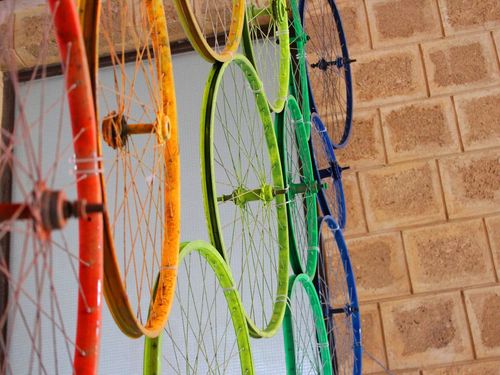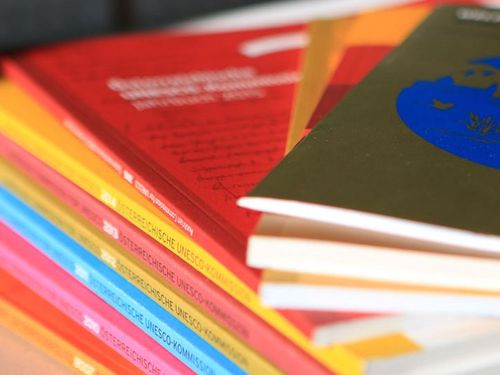"Beyond Old Geographies and New Movements" - by Khadija El Bennaoui
This keynote speech was delivered by Khadija El Bennaoui on May, 4th 2023, during the Symposium “Global Asymmetries in the Arts & Culture. Mobility: Privilege and Problem”, which was organised by the Austrian Commission for UNESCO, the Institute for Cultural Management and Gender Studies (MDW) and IG Bildende Kunst.
This keynote was based on a reflection on the work of Art Moves Africa, [1]the first fund supporting arts and culture mobility within the African continent.
I was hired in 2005 by the founders to set up and manage the organisational structure of the fund. But the story behind the creation of the fund goes way back.
In 2001, a group of African artists and cultural practitioners gathered in Cairo, Nairobi and Harare to establish links between organisations and individuals and to create informal networks across the continent. Participants came to the ironic conclusion that they usually meet their counterparts from the continent during events taking place in Europe or North America.
Cities like Paris, Brussels and Amsterdam have become the birthplace of collaborative projects between North Africans and West Africans or between East Africans and Central Africans. As a theatre practitioner myself in Morocco in the 1990s, I had the chance to discover the francophone African theatre brought by the French diplomatic network to my country.
I was pleased and appreciative to have access to this kind of theatre production.
But I had no idea that I was missing other narratives and stories, as curation and facilitation took place through the channels of foreign cultural diplomacy and soft power.
Those channels do not only praise the role played by the French network in the development of the theatre sector in my country and on the continent. They promote a certain worldview as well. Couple of years later, I got the opportunity to travel abroad and expand my networks beyond the French speaking world. I was fortunate to experience other worldviews and adopt more critical thinking, paving the way for more opportunities and choices both professionally and personally. My journey has led to the same conclusions drawn by the aforementioned group of African artists and practitioners, who expressed a need to tell our stories on our own terms and in our own languages without outside facilitation. I shared a similar trajectory with that group. We all had a background in the performing arts. We had the opportunity to travel and explore the world beyond any unilateral vision. We also felt the same frustration with our own countries where the public and private sectors invested little in arts and culture. We all agreed that the persistent lack of funds allocated specifically for travel is one of the major obstacles to the mobility of artists and cultural professionals in Africa.
Based on this assessment, we decided to create a fund to support mobility of those practitioners within Africa to weave stories from the continent to the continent, but also to the rest of the world.
The Art Moves Africa initiative was a result of that reflection on the state of partnership in Africa. It was born in 2005 to facilitate cultural and artistic exchanges within the African continent through travel grants in order to engage in the exchange of information, the enhancement of skills, the development of informal networks, and the pursuit of cooperation. One thing leading to another, we realised after providing hundreds of grants, that the issue is not only the lack of funds, but also the access to information and the quality of infrastructure related to artistic mobility. We have made the decision to invest in mapping mobility funding and infrastructure opportunities throughout every region of the continent including in East, Central, North and West African regions. We observed with great interest the formation of discipline based networks and platforms. AMA statistics indicated that the dance sector was the most active in terms of intra-continental mobility.
Consequently, we commissioned a study to one of the actors of the sector to help us grasp its dynamics, but also to offer a toolkit to enhance mobility of dance practitioners. This keynote is also inspired by the finding of that study[2]. Since its launch in 2005 till 2020, 24% of applications received by AMA are of the dance field, which represents the highest percentage in comparison with the other artistic disciplines. This data reveals how mobility, circulation and movement are inherent in the dance practice. Needless to say that dance is movement in itself. Dancers and choreographers need to travel to learn, to sharpen their skills, to seek inspiration, to create, to present their work and to meet audiences.
The sector is carried by practitioners who were confronted since their first steps to the scarcity of means and opportunities in terms of infrastructure and funding. But, they strived against all odds. Few of them made their way to the European dance hubs. They got the training they aspired for while working with their counterparts. They made the European stages look more diverse and appealing to the diverse demographics of European cities. They didn’t stay forever in Europe. As would argue some right-wing politicians, if they are allowed in, they will stay and they will not return to where they came from. But, they are dancers and their creativity is nurtured by the logic of free movement and travel. They can’t stay in one place, and they can’t be confined within the logic of the policies of borders and visas.
Mobility is also the strategy adopted by the dancers and choreographers to address the needs of the dance communities back home. They initiated festivals, set up training programmes, created schools and venues while advocating for their sector to be taken seriously by the local stakeholders. Those efforts are now paying off. Today aspiring dancers and choreographers have access to training either in their home country or in a neighbouring country. Because leading choreographers like Germaine Acogny, Salia Sanou, Faustin Linyekula, Taoufiq Izzediou, Andreya Ouamba, Qudus Onikeku, Panaibra Gabriel, etc. to mention just a few, paved the path and created training, production and presentation platforms for the youngest generations.
By doing so, they also created spaces where artists from Europe and beyond are invited on the basis of artistic collaborations and exchange, but not on the basis of cultural diplomacy and exercise of soft power. For the realisation of AMA focused study on dance Virginie Dupray, our researcher, interviewed the sector practitioners for a better understanding of the state of the arts of mobility in their discipline.
The interviews revealed that :
- Mobility is essential in the artistic trajectory and for becoming, personally and professionally.
- Travelling abroad because of the artistic practice provides recognition and credibility in the eyes of the community and authorities. The first reason for travel in the dance field is training. 44% of applications received from the dance community by AMA are for training, while 32% were for participation in festivals.
- With mobility, we also change our perspectives and question our view of the world as well as the way we work and act. Even our relationship with our body changes depending on whether we’ve lived permanently in the same place or if we lived in various places socio-culturally and environmentally different. We don’t only discover new body languages and aesthetics, we might also realise how our body is too confined or free depending on where we come from and on where we go to.
As described here in the words of Burkina Faso born dancer Adonis Nebie: “In the beginning, my dancing was very athletic, physical, I danced like a gymnast. Literally, my body was producing the story. Before then, I was dancing, today I am a man who has things to say and who puts them on stage. And even before starting to work in the studio, I wonder why I dance.”[3]
- Mobility is not black or white, it’s an ongoing process of exchange between different localities facilitated by the artists.
Some made the choice to settle elsewhere, to create and produce, than their country of birth. Others decided to get back to their origin territory, or to engage in a process of back and forth movement to build and share. Whatever is their choice, it is vital to be able to move freely between the place of residence and where there is better opportunity or where the artist is emotionally and professionally engaged.
Dancers need “to have one foot on each side for better balance” as eloquently expressed by dance producer Virginie Dupray. That back and forth is also essential to figure out who we are, what we want, what make us unique and what would be our added value. Those who have the chance to move freely are not only building artistic scenes back home, they are also contributing to the richness and to the diversity of the global dance scene. They refuse to be reduced into exotic or geo-political labels.
It is this thriving dance sector that contributed to the structures and platforms existing today in the continent. Europe remains an essential partner in the equation, but not an end in itself. Different initiatives like Art Moves Africa came to support this dynamic allowing, not only for artists to collaborate with their counterparts, but also for audiences to have access to stories from the continent. Despite the ongoing efforts by civil society initiatives, the challenge is still big to overcome the obstacles of mobility, especially those related to the infrastructure, the administrative hurdles, and the funding. Artists have to permanently reinvent themselves and their practice as they recently did when faced with the COVID-19 pandemic that hit the very core of the performing arts.
On this note, I would like to conclude with a video letter[4] from Kinshasa by the Collective D’Art D’Art, commissioned as part of “Letters from the continent” a film, produced by Kisangani based Studios Kabako, showcasing 21 video letters, self-portraits of the new generation of dance and performing arts practitioners across 16 countries in Africa.
Khadija El Bennaoui
Vienna, 04/05/2023
[2] Dupray, V (2023) Danse et mobilités en Afrique. Art Moves Africa (AMA) Publication Series.
[3] Dupray, V (2023) Danse et mobilités en Afrique. Art Moves Africa (AMA) Publication Series
[4] The video letter can be viewed from 26:38 to 31:47





